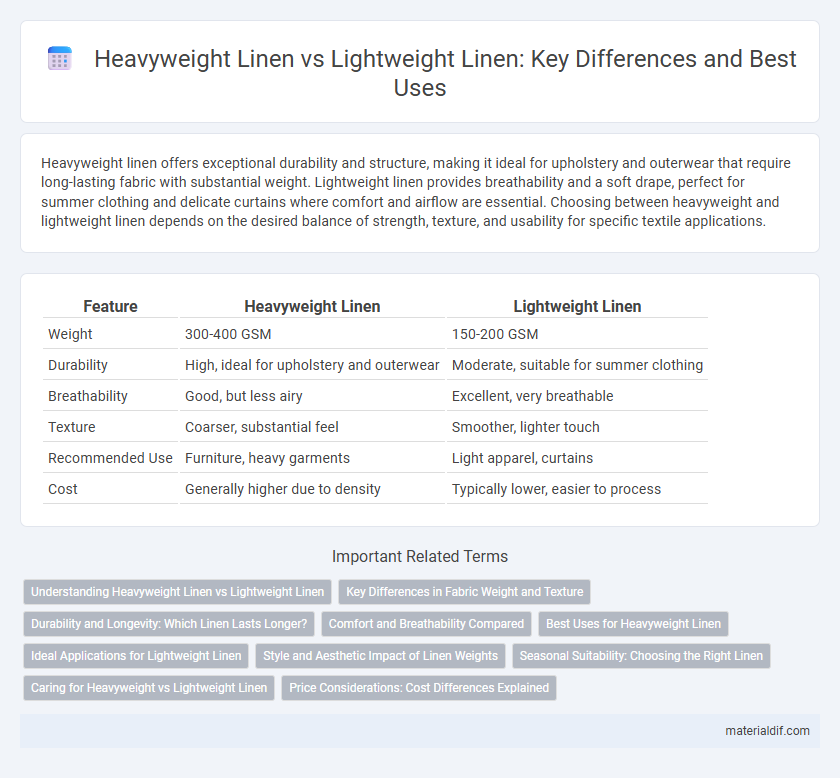Heavyweight linen offers exceptional durability and structure, making it ideal for upholstery and outerwear that require long-lasting fabric with substantial weight. Lightweight linen provides breathability and a soft drape, perfect for summer clothing and delicate curtains where comfort and airflow are essential. Choosing between heavyweight and lightweight linen depends on the desired balance of strength, texture, and usability for specific textile applications.
Table of Comparison
| Feature | Heavyweight Linen | Lightweight Linen |
|---|---|---|
| Weight | 300-400 GSM | 150-200 GSM |
| Durability | High, ideal for upholstery and outerwear | Moderate, suitable for summer clothing |
| Breathability | Good, but less airy | Excellent, very breathable |
| Texture | Coarser, substantial feel | Smoother, lighter touch |
| Recommended Use | Furniture, heavy garments | Light apparel, curtains |
| Cost | Generally higher due to density | Typically lower, easier to process |
Understanding Heavyweight Linen vs Lightweight Linen
Heavyweight linen typically ranges from 6 to 10 ounces per yard, offering durability, structure, and warmth ideal for upholstery or outerwear, while lightweight linen usually weighs 3 to 5 ounces per yard, providing breathability and comfort suited for summer clothing and curtains. The fiber density and weave tightness in heavyweight linen result in a coarser texture and longer drying time, in contrast to the softer, more pliable hand feel and quicker drying properties of lightweight linen. Understanding these differences allows consumers to select the appropriate linen type based on application, climate, and desired garment or textile performance.
Key Differences in Fabric Weight and Texture
Heavyweight linen typically ranges from 7 to 12 ounces per square yard, offering a dense, sturdy texture ideal for upholstery and outerwear, while lightweight linen weighs between 3 to 5 ounces, providing a breathable, softer feel perfect for summer clothing and delicate curtains. The fabric weight directly impacts durability and drape, with heavyweight linen delivering robust resilience and pronounced texture, whereas lightweight linen excels in flexibility and a smooth, airy hand. Understanding these distinctions helps in selecting linen suitable for specific applications, balancing comfort, appearance, and functional performance.
Durability and Longevity: Which Linen Lasts Longer?
Heavyweight linen is known for its superior durability and longer lifespan compared to lightweight linen due to its dense weave and thicker fibers. This type of linen resists wear and tear better, making it ideal for upholstery, heavy-use garments, and home textiles that require longevity. Lightweight linen, while breathable and soft, is more prone to fraying and wear, resulting in a shorter lifespan under frequent use.
Comfort and Breathability Compared
Heavyweight linen offers durability and warmth but may feel less breathable and heavier on the skin, making it ideal for cooler climates or structured garments. Lightweight linen excels in comfort and breathability, allowing better air circulation and moisture wicking, perfect for hot weather and relaxed styles. Choosing between heavyweight and lightweight linen depends on the desired balance of insulation and ventilation for specific uses.
Best Uses for Heavyweight Linen
Heavyweight linen excels in upholstery, drapery, and outerwear due to its durability and substantial texture, providing long-lasting performance and structure. Its dense weave makes it ideal for items requiring strength and resistance to wear, such as tote bags, cushions, and jackets. The robust nature of heavyweight linen also lends excellent insulation properties, making it suitable for colder weather apparel and home furnishings.
Ideal Applications for Lightweight Linen
Lightweight linen is ideal for summer clothing such as shirts, blouses, and dresses due to its breathable, moisture-wicking properties that keep the wearer cool and comfortable. It is also well-suited for curtains and drapes, allowing natural light to filter through while providing a soft texture and elegant appearance. Lightweight linen's delicate weave makes it perfect for layering pieces and casual wear in warm climates, promoting airflow and ease of movement.
Style and Aesthetic Impact of Linen Weights
Heavyweight linen delivers a robust, textured appearance that enhances structured garments and home decor with a classic, durable feel. Lightweight linen offers a breezy, ethereal look ideal for flowing apparel and airy interiors, emphasizing softness and subtle drape. Selecting between heavyweight and lightweight linen significantly influences the garment's silhouette and the space's ambiance, balancing visual weight and tactile experience.
Seasonal Suitability: Choosing the Right Linen
Heavyweight linen provides excellent insulation, making it ideal for colder seasons or transitional weather, while lightweight linen offers breathability and moisture-wicking properties perfect for hot and humid climates. The fabric's weave density and fiber weight directly influence its thermal regulation, ensuring comfort across different temperature ranges. Selecting the right linen based on seasonal suitability enhances durability and wearability, optimizing wardrobe functionality year-round.
Caring for Heavyweight vs Lightweight Linen
Heavyweight linen requires less frequent washing due to its dense fibers, which resist dirt and wear better than lightweight linen but should be machine washed in cold water on a gentle cycle to maintain its durability. Lightweight linen, being more delicate and breathable, benefits from more frequent washing to preserve its softness and prevent buildup of oils, ideally hand-washed or machine washed on a cold, gentle cycle and air-dried to avoid shrinkage. Both types of linen should be ironed while slightly damp or steamed to retain texture and strength, with heavyweight linen tolerating more robust care methods than its lightweight counterpart.
Price Considerations: Cost Differences Explained
Heavyweight linen typically commands a higher price due to its denser fabric and greater durability, making it ideal for upholstery and outerwear. Lightweight linen, favored for summer apparel and curtains, is generally more affordable because it uses less material and requires less processing. Understanding these cost differences helps consumers balance budget with the intended use and longevity of the linen product.
Heavyweight Linen vs Lightweight Linen Infographic

 materialdif.com
materialdif.com